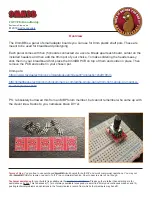
4
•
Avoid allowing the analyzer to get wet. It is not a water-resistant
structure. Any leakage of liquid into the analyzer may cause damage to
the analyzer or an electric shock to the user.
•
Use a power source (voltage, frequency, outlet type)
adapted to the specification of the analyzer. If excessive
voltage is used, the analyzer may overheat and be damaged or cause a
fire.
•
Do not measure samples that could cause a dangerous chemical
reaction or create an explosion or poisonous gas when the sample is
dried.
•
Keep flammables away from the analyzer. Parts of the analyzer
become very hot. Materials placed near it might catch fire.
•
Do not touch the heater cover, the halogen lamp,
glass-housing, pan handle, sample pan or sample without
adequate protection, burns or scalding may result.
•
Parts of the analyzer are very hot when a measurement finishes. For
operation, use the specified grips of the heater cover and pan handle.
Use the standard accessory tools.
•
Toxic gases produced during the drying process of
substances containing toxic or corrosive ingredients may
cause irritation (eyes, skin, breathing), illness or death. Such substances
may be dried only in a fume cupboard.






































